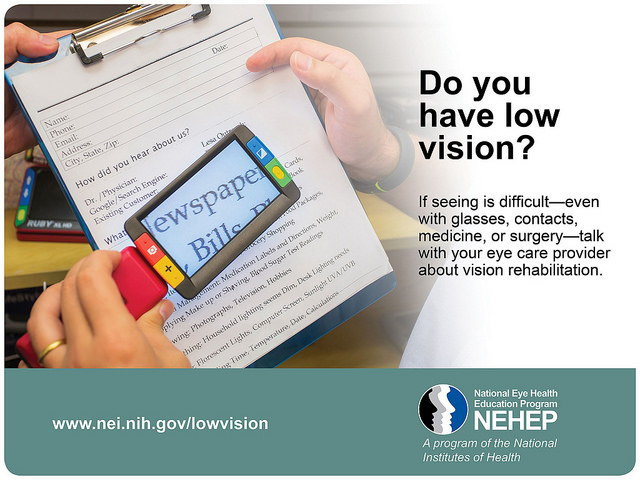Help for People With Vision Loss
Here’s eye-opening news: Currently, 4.2 million Americans ages 40 and older are visually impaired. Of these, 3 million have low vision. By 2030, when the last baby boomers turn 65, the number of Americans who have visual impairments is projected to reach 7.2 million, with 5 million having low vision. For the millions of people who currently live or will live with low vision, the good news is there is help.

But first, what is low vision? Low vision is when even with regular glasses, contact lenses, medicine, or surgery, people have difficulty seeing, which makes everyday tasks difficult to do. Activities that used to be simple like reading the mail, shopping, cooking, and writing can become challenging.
Most people with low vision are age 65 or older. The leading causes of vision loss in older adults are age-related macular degeneration, diabetic retinopathy, cataract, and glaucoma. Among younger people, vision loss is most often caused by inherited eye conditions, infectious and autoimmune eye diseases, or trauma. For people with low vision, maximizing their remaining sight is key to helping them continue to live safe, productive, and rewarding lives. The first step is to seek help.
“I encourage anyone with low vision to seek guidance about vision rehabilitation from a low vision specialist,” advises Paul A. Sieving, MD, PhD, director of the National Eye Institute (NEI), one of the National Institutes of Health (NIH) and the federal government’s principal agency for vision research.
What is a low vision specialist? A low vision specialist is an ophthalmologist or optometrist who works with people who have low vision. A low vision specialist can develop a vision rehabilitation plan that identifies strategies and assistive devices appropriate for the person’s particular needs. “A vision rehabilitation plan helps people reach their true visual potential when nothing more can be done from a medical or surgical standpoint,” explains Mark Wilkinson, O.D., a low vision specialist at the University of Iowa Hospitals and Clinics and chair of the low vision subcommittee for the National Eye Health Education Program (NEHEP).
Vision rehabilitation can include the following:
- Training to use magnifying and adaptive devices
- Teaching new daily living skills to remain safe and live independently
- Developing strategies to navigate around the home and in public
- Providing resources and support
There are also many resources available to help people with low vision. NEI offers a 20-page, large-print booklet, titled What You Should Know About Low Vision, and companion DVD, featuring inspiring stories of people living with low vision. This booklet and DVD, among other resources, are available at
www.nei.nih.gov/lowvision.
With the aging of the population, eye diseases and vision loss have become major public health concerns in the United States. NEI is committed to finding new ways to improve the lives of people living with visual impairment. Aside from making information and resources readily available, NEI has dedicated more than $24 million to research projects on low vision, including learning how the brain adapts to vision loss; strategies to improve vision rehabilitation; and the development of new technologies that help people with low vision to read, shop, and find their way in unfamiliar places. Research like this will help people with low vision to make the most of their remaining vision and maintain their independence and quality of life.
2/17/15
 The National Eye Health Education Program (NEHEP) of the National Eye Institute (NEI), a part of NIH, offers a 20-page, large-print booklet, titled What You Should Know About Low Vision, and a series of videos featuring patient stories about living with low vision. These and other resources are available at http://www.nei.nih.gov/lowvision.
The National Eye Health Education Program (NEHEP) of the National Eye Institute (NEI), a part of NIH, offers a 20-page, large-print booklet, titled What You Should Know About Low Vision, and a series of videos featuring patient stories about living with low vision. These and other resources are available at http://www.nei.nih.gov/lowvision.

